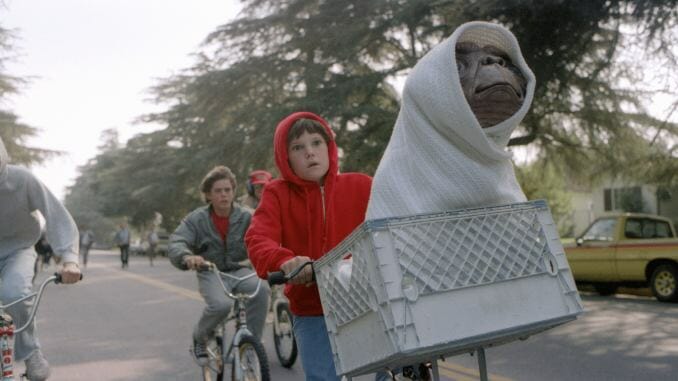What Exactly Is an Amblin Movie?

Nostalgia is a hell of a drug.
In the summer of 1982, Steven Spielberg and Universal Pictures released E.T. the Extra-Terrestrial. The movie was a smash hit, breaking box office records, adding acclaim to Spielberg’s already impressive body of work and creating an entire subgenre. While not the first film produced under Spielberg’s Amblin Entertainment (aptly named after Spielberg’s first commercially released film, the short Amblin’), E.T. would give the production company its logo: A short animation featuring Elliott and E.T. on a bicycle flying in silhouette past the moon, replicating the most memorable sequence in the movie.
In the 40 years since E.T., the name Amblin has been used to describe a certain kind of coming-of-age adventure. Featuring specific elements—children with absent or otherwise distracted parents, the freedom of bicycles in a child’s life, raging hormones, overreach from authority figures and pushed boundaries of horror imagery acceptable in a family film. These qualities are vital to making what is known as an “Amblin movie.”
Movies such as The Goonies and Super 8 have drawn from these specific traits—attempting to capture that same magic by utilizing many similar story elements, expanding where they deemed necessary, or copying straight-up wholesale—to varying success, and this formula has been repeated on television in shows like Stranger Things. Even Star Wars is planning on drawing inspiration from Amblin, as Spider-Man trilogy director Jon Watts is looking for four child actors to co-star with Jude Law in his Star Wars: Skeleton Crew series.
It’s vital to recognize just how influential Spielberg’s story remains today. It managed to capture youth in a bottle and sell it to the world via celluloid. The nostalgia that these titles emphasize isn’t genetically tied to the ‘80s (although some of these titles desperately try to capture that era.) Rather, this subgenre focuses on the timeless fears of adolescence that everyone faces and how an epic adventure can change a life forever.
Here are the elements making up an Amblin film:
Family Drama
E.T.’s Elliott (Henry Thomas) became the prototypical Amblin kid blueprint. Being ten is hard enough, but his parents have recently separated, and that absence is felt by his entire family. His siblings Michael (Robert MacNaughton) and Gertie (Drew Barrymore) are handling the separation in different ways; Michael chooses not to discuss it, enjoying his youth driving cars and playing Dungeons & Dragons with his friends, while Gertie is still a little too young to fully understand the ramifications. When E.T. comes into their lives, the alien fills the absence in their home, providing Elliott a chance to grow up exponentially from this otherworldly encounter.
Super 8 is intrinsically tied to the Amblin formula, so much that director J.J. Abrams had the old Amblin logo dusted off for the beginning of the feature. Spielberg was even part of the project as a producer. Super 8’s Joe Lamb (Joel Courtney) is reeling from the tragic death of his mother, but he’s not the only one suffering. His father, Deputy Jackson Lamb (Kyle Chandler), was always able to count on his wife to take care of his son and his home. Now he has to split his responsibilities as a cop and father, as the greatest threat to his town is on its way. Their grief manifests in different ways, but the most significant item that Joe holds onto is a pendant given to him by his mother, which plays a pivotal part in the conclusion. Super 8’s family dynamic drives many of the most significant dilemmas in the movie.
-

-

-

-

-

-

-

-

-

-

-

-

-

-

-

-

-

-

-

-

-

-

-

-

-

-

-

-

-

-

-

-

-

-

-

-

-

-

-

-








































